 By Bob Currie, Vessel Examiner
By Bob Currie, Vessel Examiner
United States Coast Guard Auxiliary Station Galveston Flotilla
Of the 658 boating accident deaths recorded in 2017, the latest year for which we have statistics, 500 were due to drowning. Of those 500 victims, 421 would probably have survived if they had been wearing a properly fitting Coast Guard approved life jacket.
The Station Galveston Flotilla of the US Coast Guard Auxiliary operates out of the USCG Station Galveston base on Galveston Island. They provide assistance to the Coast Guard by providing maritime observation patrols in Galveston Bay; by providing recreational boating vessel safety checks; and by working alongside Coast Guard members in maritime accident investigation, small boat training, watch standing, and property administration.
The captain of this charter boat below had never required anyone on board to wear a life jacket. When his boat capsized 5 miles offshore, his deckhand swam below the capsized boat and was able to pull some lifejackets from the storage locker. His captain said that from now on he would not leave the dock until everyone was wearing a life jacket.
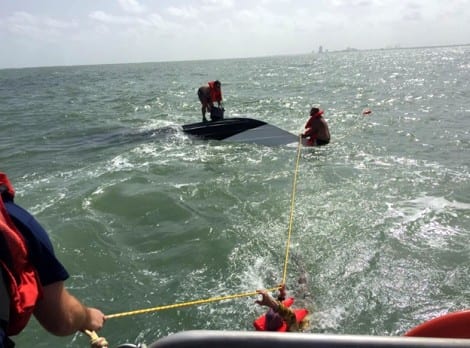
Common Excuses for Not Wearing a Life Jacket
The two most common excuses people use for not wearing a life jacket are (1) it’s too hot, and (2) it’s too cold. When the ambient temperature out there on the water is 100 degrees, a bulky life jacket can add to the misery. When the air temperature drops during the winter and wearing a jacket is necessary to keep warm, it can be difficult to don the average life jacket over your regular jacket. There are products out there to cover both situations. Neither type of product is cheap, but if comfort on the water is important, then these products can increase your safety and comfort, and I am all for that. Let’s take a look at them as well as the other types of PFDs.
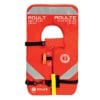 Type I – Buoyancy at least 22 pounds
Type I – Buoyancy at least 22 pounds
Type I PFDs, or offshore lifejackets, are the most buoyant PFDs and suitable for all water conditions, including rough or isolated water where rescue may be delayed. Although bulky in comparison to Type II and III PFDs, offshore lifejackets will turn most unconscious individuals to the face-up position. They range in sizes from adult to child.
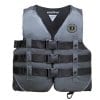 Type II – Buoyancy at least 15.5 pounds
Type II – Buoyancy at least 15.5 pounds
Type II PFDs – or near-shore buoyant vests – are for calm and inland water where a rescue will most likely occur quickly. These are not designed for long periods in rough water, and will turn some – but not all – unconscious wearers face-up in the water. This vest is less bulky and more comfortable than a Type I, and often the least expensive of the PFD types.
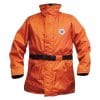 Type 3 PFD – Buoyancy at least 15.5 pounds
Type 3 PFD – Buoyancy at least 15.5 pounds
Type III PFDs – or flotation aids – are for calm and inland water where a rescue will most likely occur quickly. These PFDs are designed to keep the wearer in a vertical position, but it is the wearer’s responsibility to maneuver themselves into a face-up position. These types of PFDs are the most comfortable to wear, and popular for recreational boating and fishing. Type III PFD’s can be coats, jackets and vests. Depending on the product, the wearer may have to tilt their head back to avoid being face down in the water. Type III PFDs are not meant for extended survival in rough water, as high waves may cover the wearer’s face. The Type III PFD pictured here is commonly called a float coat. This is the type PFD I was referring to as an option to wear when the air temperature is cool. It is not only a PFD, it is a smart looking jacket that can be worn out of the water as well without the wearer looking like he has lost his boat. They also come in camouflage for the hunters out there.
Other Type III PFDs include special speed-rated PFDs for personal watercraft (PWC) operators, PFDs with plenty of arm room for kayakers, and special PFDs that go around the waste like a fanny pack for paddleboard operators.
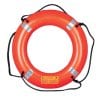 Type IV – no buoyancy requirement
Type IV – no buoyancy requirement
These are designed to be thrown to a conscious person in the water. These are not designed to be worn. A few examples of a Type IV PFD are a buoyant cushion, a life ring, or a horseshoe buoy. The Coast Guard recommends having a spare Type IV PFD with a line attached to be used to rescue persons in the water. There is no requirement to have a line attached, but the regulations require that you have at least one throw cushion or ring buoy immediately available. This means it cannot be stored in a locker.
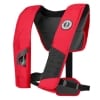 Type V Inflatable PFD – Buoyancy Varies
Type V Inflatable PFD – Buoyancy Varies
These special use devices are to be worn for specific activities that will be described on the PFD’s label. To be effective, Type V PFDs must be used according to these specifications, and many must be worn at all times in order to qualify as a PFD. A Type V label will also list its performance as Type I, II, or III. You can’t leave these in the locker; you must wear it when underway. But you might as well wear it at all times, as you can fall out of the boat even when not making way. They are so comfortable that I have often forgotten to take mine off.
There are two types of the inflatable Type V PFDs like the one shown above. One is manual inflation only, and the other is manual or automatic inflation. I have both types. I recommend the kind that inflates automatically, as it is possible to enter the water and be knocked unconscious before you can activate your vest. There is something you need to know about the automatic activation vests: they are activated when a salt block dissolves upon contact with water, and the humidity in our area is high enough to dissolve that salt block and activate your vest while it is being stored. I have had that happen to me even though my vest was stored in a “waterproof” locker. So, I now keep my automatic vest in my truck, which prevents moisture from dissolving the salt block. I always have a backup Type III in the boat in case I forget to put my automatic vest on.
Summary
You can wear a vest at all times and still be comfortable. The automatically inflating Type V PFD is great when the air temperature is hot, while the Type III float jacket is great for cold weather boating. Remember: PFDs only work if you are wearing them.
For more information on boating safety, please visit the Official Website of the U.S. Coast Guard’s Boating Safety Division at www.uscgboating.org. Questions about the US Coast Guard Auxiliary or our free Vessel Safety Check program may be directed to me at [email protected]. I am available to perform free Vessel Safety Checks, and I will come to your location to perform them. SAFE BOATING!
[3-11-2019]

 Posted in
Posted in 























